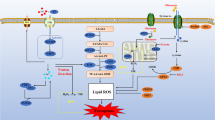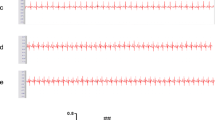Abstract
Penehyclidine hydrochloride (PHC) is an anticholinergic drug with cardioprotective effects. Ferroptosis is closely related to myocardial ischaemia-reperfusion injury (MIRI). In the present study, MIRI was induced in rats by left anterior descending coronary artery ligation. PHC pretreatment increased haemodynamic parameters and histopathological damage and reduced myocardial infarction size in the MIRI model. PHC pretreatment also inhibited ferroptosis, which was characterized by the decreased levels of Fe2+, 4-hydroxynonenal and ACSL4, and increased levels of GPX4, GSH-Px and GST. In response to 6 h of oxygen-glucose deprivation and 18 h of reoxygenation, PHC pretreatment had the same effects on these factors in H9c2 cells and reduced lipid ROS levels. Furthermore, ACSL4 overexpression reversed the protective effects of PHC on H9c2 cells. These results indicated that PHC inhibited MIRI through ACSL4-mediated ferroptosis. This study demonstrated that PHC could inhibit ferroptosis in MIRI and the relationship among PHC, ACSL4, ferroptosis and MIRI.
Graphical Abstract
This study demonstrated the inhibitory effect of PHC on ferroptosis and showed that PHC affects MIRI through ACSL4-mediated ferroptosis in vivo and in vitro.





Similar content being viewed by others
Data Availability
All data used for figures and results are available from the corresponding author on reasonable request.
References
Scirica BM, Bergmark BA, Morrow DA, Antman EM, Bonaca MP, Murphy SA, et al (2020) Nonculprit Lesion Myocardial Infarction Following Percutaneous Coronary Intervention in Patients With Acute Coronary Syndrome. J Am Coll Cardiol 1095–106. https://doi.org/10.1016/j.jacc.2019.12.067.
Sanchez-Hernandez CD, Torres-Alarcon LA, Gonzalez-Cortes A, Peon AN (2020) Ischemia/Reperfusion Injury: Pathophysiology, Current Clinical Management, and Potential Preventive Approaches. Mediators Inflamm 8405370. https://doi.org/10.1155/2020/8405370.
Neri M, Riezzo I, Pascale N, Pomara C, Turillazzi E (2017) Ischemia/Reperfusion Injury following Acute Myocardial Infarction: A Critical Issue for Clinicians and Forensic Pathologists. Mediators Inflamm 7018393. https://doi.org/10.1155/2017/7018393.
Schanze N, Bode C, Duerschmied D (2019) Platelet Contributions to Myocardial Ischemia/Reperfusion Injury. Front Immunol 1260. https://doi.org/10.3389/fimmu.2019.01260.
Dixon SJ, Lemberg KM, Lamprecht MR, Skouta R, Zaitsev EM, Gleason CE, et al (2012) Ferroptosis: an iron-dependent form of nonapoptotic cell death. Cell 1060–72. https://doi.org/10.1016/j.cell.2012.03.042.
Yan HF, Zou T, Tuo QZ, Xu S, Li H, Belaidi AA, et al (2021) Ferroptosis: mechanisms and links with diseases. Signal Transduct Target Ther 49. https://doi.org/10.1038/s41392-020-00428-9.
Liu J, Kang R, Tang D (2022) Signaling pathways and defense mechanisms of ferroptosis. FEBS J 7038–50. https://doi.org/10.1111/febs.16059.
Doll S, Proneth B, Tyurina YY, Panzilius E, Kobayashi S, Ingold I, et al (2017) ACSL4 dictates ferroptosis sensitivity by shaping cellular lipid composition. Nat Chem Biol 91–8. https://doi.org/10.1038/nchembio.2239.
Wang Y, Zhang M, Bi R, Su Y, Quan F, Lin Y, et al (2022) ACSL4 deficiency confers protection against ferroptosis-mediated acute kidney injury. Redox Biol 102262. https://doi.org/10.1016/j.redox.2022.102262.
Li Y, Feng D, Wang Z, Zhao Y, Sun R, Tian D, et al (2019) Ischemia-induced ACSL4 activation contributes to ferroptosis-mediated tissue injury in intestinal ischemia/reperfusion. Cell Death Differ 2284–99. https://doi.org/10.1038/s41418-019-0299-4.
Tuo QZ, Liu Y, Xiang Z, Yan HF, Zou T, Shu Y, et al (2022) Thrombin induces ACSL4-dependent ferroptosis during cerebral ischemia/reperfusion. Signal Transduct Target Ther 59. https://doi.org/10.1038/s41392-022-00917-z.
Xu Y, Li X, Cheng Y, Yang M, Wang R (2020) Inhibition of ACSL4 attenuates ferroptotic damage after pulmonary ischemia-reperfusion. FASEB J 16262–75. https://doi.org/10.1096/fj.202001758R.
Fan Z, Cai L, Wang S, Wang J, Chen B (2021) Baicalin Prevents Myocardial Ischemia/Reperfusion Injury Through Inhibiting ACSL4 Mediated Ferroptosis. Front Pharmacol 628988. https://doi.org/10.3389/fphar.2021.628988.
Tang LJ, Luo XJ, Tu H, Chen H, Xiong XM, Li NS, et al (2021) Ferroptosis occurs in phase of reperfusion but not ischemia in rat heart following ischemia or ischemia/reperfusion. Naunyn Schmiedebergs Arch Pharmacol 401–10. https://doi.org/10.1007/s00210-020-01932-z.
Xiao HT, Liao Z, Tong RS (2012) Penehyclidine hydrochloride: a potential drug for treating COPD by attenuating Toll-like receptors. Drug Des Devel Ther 317–22. https://doi.org/10.2147/DDDT.S36555.
Liu Z, Li Y, Yu L, Chang Y, Yu J (2020) Penehyclidine hydrochloride inhibits renal ischemia/reperfusion-induced acute lung injury by activating the Nrf2 pathway. Aging (Albany NY) 13400–21. https://doi.org/10.18632/aging.103444.
Wang YP, Li G, Ma LL, Zheng Y, Zhang SD, Zhang HX, et al (2014) Penehyclidine hydrochloride ameliorates renal ischemia-reperfusion injury in rats. J Surg Res 390–7. https://doi.org/10.1016/j.jss.2013.07.041.
Zhang Y, Leng YF, Xue X, Zhang Y, Wang T, Kang YQ (2011) Effects of penehyclidine hydrochloride in small intestinal damage caused by limb ischemia-reperfusion. World J Gastroenterol 254–9. https://doi.org/10.3748/wjg.v17.i2.254.
Yu C, Wang J (2013) Neuroprotective effect of penehyclidine hydrochloride on focal cerebral ischemia-reperfusion injury. Neural Regen Res 622–32. https://doi.org/10.3969/j.issn.1673-5374.2013.07.006.
Zi C, Zhang C, Yang Y, Ma J (2020) Penehyclidine hydrochloride protects against anoxia/reoxygenation injury in cardiomyocytes through ATP-sensitive potassium channels, and the Akt/GSK-3beta and Akt/mTOR signaling pathways. Cell Biol Int 1353–62. https://doi.org/10.1002/cbin.11329.
Yang Y, Zhao L, Ma J (2017) Penehyclidine hydrochloride preconditioning provides cardiac protection in a rat model of myocardial ischemia/reperfusion injury via the mechanism of mitochondrial dynamics mechanism. Eur J Pharmacol 130–9. https://doi.org/10.1016/j.ejphar.2017.07.031.
Lin D, Ma J, Xue Y, Wang Z (2015) Penehyclidine Hydrochloride Preconditioning Provides Cardioprotection in a Rat Model of Myocardial Ischemia/Reperfusion Injury. PLoS One e0138051. https://doi.org/10.1371/journal.pone.0138051.
Lin D, Cui B, Ren J, Ma J (2018) Regulation of VDAC1 contributes to the cardioprotective effects of penehyclidine hydrochloride during myocardial ischemia/reperfusion. Exp Cell Res 257–63. https://doi.org/10.1016/j.yexcr.2018.04.004.
Galluzzi L, Vitale I, Aaronson SA, Abrams JM, Adam D, Agostinis P, et al (2018) Molecular mechanisms of cell death: recommendations of the Nomenclature Committee on Cell Death 2018. Cell Death Differ 486–541. https://doi.org/10.1038/s41418-017-0012-4.
Chen X, Li J, Kang R, Klionsky DJ, Tang D (2021) Ferroptosis: machinery and regulation. Autophagy 2054–81. https://doi.org/10.1080/15548627.2020.1810918.
Zhang Y, Xin L, Xiang M, Shang C, Wang Y, Wang Y, et al (2022) The molecular mechanisms of ferroptosis and its role in cardiovascular disease. Biomed Pharmacother 112423. https://doi.org/10.1016/j.biopha.2021.112423.
Park TJ, Park JH, Lee GS, Lee JY, Shin JH, Kim MW, et al (2019) Quantitative proteomic analyses reveal that GPX4 downregulation during myocardial infarction contributes to ferroptosis in cardiomyocytes. Cell Death Dis 835. https://doi.org/10.1038/s41419-019-2061-8.
Sampilvanjil A, Karasawa T, Yamada N, Komada T, Higashi T, Baatarjav C, et al (2020) Cigarette smoke extract induces ferroptosis in vascular smooth muscle cells. Am J Physiol Heart Circ Physiol H508-H18. https://doi.org/10.1152/ajpheart.00559.2019.
Libby P, Buring JE, Badimon L, Hansson GK, Deanfield J, Bittencourt MS, et al (2019) Atherosclerosis. Nat Rev Dis Primers 56. https://doi.org/10.1038/s41572-019-0106-z.
Lillo-Moya J, Rojas-Sole C, Munoz-Salamanca D, Panieri E, Saso L, Rodrigo R. Targeting Ferroptosis against Ischemia/Reperfusion Cardiac Injury. Antioxidants (Basel). 2021. https://doi.org/10.3390/antiox10050667.
Nakamura T, Naguro I, Ichijo H (2019) Iron homeostasis and iron-regulated ROS in cell death, senescence and human diseases. Biochim Biophys Acta Gen Subj 1398–409. https://doi.org/10.1016/j.bbagen.2019.06.010.
Paterek A, Mackiewicz U, Maczewski M (2019) Iron and the heart: A paradigm shift from systemic to cardiomyocyte abnormalities. J Cell Physiol 21613–29. https://doi.org/10.1002/jcp.28820.
Zhao WK, Zhou Y, Xu TT, Wu Q (2021) Ferroptosis: Opportunities and Challenges in Myocardial Ischemia-Reperfusion Injury. Oxid Med Cell Longev 9929687. https://doi.org/10.1155/2021/9929687.
Staff PO (2016) Correction: Penehyclidine Hydrochloride Pretreatment Ameliorates Rhabdomyolysis-Induced AKI by Activating the Nrf2/HO-1 Pathway and Allevi-ating Endoplasmic Reticulum Stress in Rats. PLoS One e0154138. https://doi.org/10.1371/journal.pone.0154138.
Kwon MY, Park E, Lee SJ, Chung SW (2015) Heme oxygenase-1 accelerates erastin-induced ferroptotic cell death. Oncotarget 24393–403. https://doi.org/10.18632/oncotarget.5162.
Chang LC, Chiang SK, Chen SE, Yu YL, Chou RH, Chang WC (2018) Heme oxygenase-1 mediates BAY 11–7085 induced ferroptosis. Cancer Lett 124–37. https://doi.org/10.1016/j.canlet.2017.12.025.
Wang Y, Yan S, Liu X, Deng F, Wang P, Yang L, et al (2022) PRMT4 promotes ferroptosis to aggravate doxorubicin-induced cardiomyopathy via inhibition of the Nrf2/GPX4 pathway. Cell Death Differ 1982–95. https://doi.org/10.1038/s41418-022-00990-5.
Tan H, Chen L, Ma J (2017) Penehyclidine hydrochloride post-conditioning reduces ischemia/reperfusion-induced cardiomyocyte apoptosis in rats. Exp Ther Med 4272–8. https://doi.org/10.3892/etm.2017.5089.
Wang YA, Zhou WX, Li JX, Liu YQ, Yue YJ, Zheng JQ, et al (2005) Anticonvulsant effects of phencynonate hydrochloride and other anticholinergic drugs in soman poisoning: neurochemical mechanisms. Life Sci 210–23. https://doi.org/10.1016/j.lfs.2005.04.071.
Wang Y, Gao Y, Ma J (2018) Pleiotropic effects and pharmacological properties of penehyclidine hydrochloride. Drug Des Devel Ther 3289–99. https://doi.org/10.2147/DDDT.S177435.
Acknowledgements
We are grateful for the support from the National Natural Science Foudation of China and the Capital Medical University.
Funding
This study was supported by the National Natural Science Foundation of China (under Grant 82172151).
Author information
Authors and Affiliations
Contributions
Conception and methodology: Duomao Lin and Boqun Cui; Formal analysis: Zeyou Qi and Wenjun Liu; Supervision: Guanzheng Zhang. All authors edited the manuscript. All authors read and approved the final manuscript.
Corresponding author
Ethics declarations
Ethic Approval
All institutional and national guidelines for the care and use of laboratory animals were followed and approved by the appropriate institutional committees.
No human studies were carried out by the authors for this article.
Conflicts of Interest
The authors have no relevant financial or non-financial interests to disclose.
Disclosures
All authors declare that they have no competing interest.
Additional information
Associate Editor Guoping Li oversaw the review of this article
Publisher's Note
Springer Nature remains neutral with regard to jurisdictional claims in published maps and institutional affiliations.
Rights and permissions
Springer Nature or its licensor (e.g. a society or other partner) holds exclusive rights to this article under a publishing agreement with the author(s) or other rightsholder(s); author self-archiving of the accepted manuscript version of this article is solely governed by the terms of such publishing agreement and applicable law.
About this article
Cite this article
Lin, D., Cui, B., Qi, Z. et al. A New Aspect of Penehyclidine Hydrochloride in Alleviating Myocardial Ischemia–Reperfusion Injury: Ferroptosis. J. of Cardiovasc. Trans. Res. 16, 1373–1382 (2023). https://doi.org/10.1007/s12265-023-10420-7
Received:
Accepted:
Published:
Issue Date:
DOI: https://doi.org/10.1007/s12265-023-10420-7




